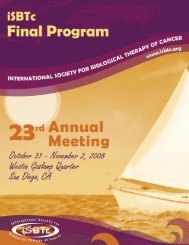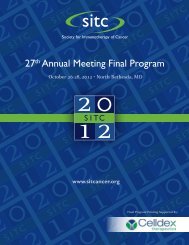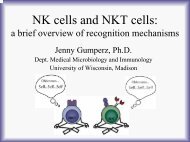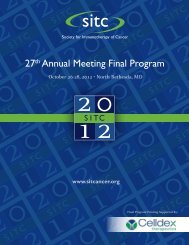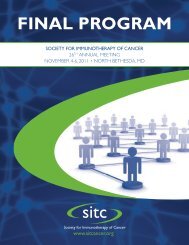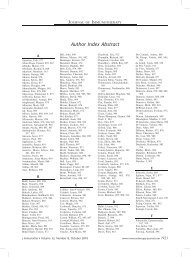Abstracts for the 25th Annual Scientific Meeting of the International ...
Abstracts for the 25th Annual Scientific Meeting of the International ...
Abstracts for the 25th Annual Scientific Meeting of the International ...
You also want an ePaper? Increase the reach of your titles
YUMPU automatically turns print PDFs into web optimized ePapers that Google loves.
J Immuno<strong>the</strong>r Volume 33, Number 8, October 2010<br />
<strong>Abstracts</strong><br />
human cancer patients, and (2) an inability to safely and effectively<br />
label human T cells and NK cells.<br />
Cell tracking <strong>of</strong> perfluorocarbon-labeled cells by 19F magnetic<br />
resonance imaging (MRI) provides a highly-specific signal to<br />
quantitatively assess in vivo migration and persistence. Previously,<br />
19F MRI has been used to observe and measure <strong>the</strong> accumulation<br />
<strong>of</strong> antigen-specific murine T cells to anatomic sites in vivo. A novel,<br />
self-delivering, perfluoropolye<strong>the</strong>r (PFPE) emulsion designed <strong>for</strong><br />
optimal MRI detection was tested <strong>for</strong> <strong>the</strong> ability to safely and<br />
effectively label human primary, in vitro-expanded T and NK<br />
lymphocytes.<br />
Activated human T lymphocytes and NK cells and were effectively<br />
labeled with PFPE, as measured by NMR spectroscopy, with no<br />
evidence <strong>of</strong> apoptosis or cell death. A dual-mode fluorescent PFPE<br />
probe revealed dose-dependent labeling by flow cytometry, and<br />
localization <strong>of</strong> <strong>the</strong> tracer within vesicles in <strong>the</strong> cytoplasm using<br />
confocal microscopy. The ability <strong>of</strong> labeled T cells to produce IFNg<br />
and proliferate in response to TCR stimulation indicated no<br />
impairment in <strong>the</strong>se effector functions. Similarly, labeled NK cells<br />
exhibited equal IFN-g secretion and cytotoxicity against target cells<br />
as <strong>the</strong>ir unlabeled counterparts.<br />
These results indicate that both T cells and NK cells can be labeled<br />
with PFPE tracer agents <strong>for</strong> MRI without alterations in functional<br />
properties. The clinical translation <strong>of</strong> this PFPE tracer <strong>for</strong> 19F MRI<br />
may enable <strong>the</strong> quantification <strong>of</strong> effective homing and persistence in<br />
<strong>the</strong> tumor microenvironment in cancer patients, significantly<br />
advancing <strong>the</strong> effectiveness <strong>of</strong> adoptive immuno<strong>the</strong>rapies.<br />
INNATE/ADAPTIVE IMMUNE<br />
INTERPLAY IN CANCER<br />
Monocytes Enhance Natural Killer Cell Cytokine Production<br />
in Response to Antibody Coated Tumor Cells in <strong>the</strong> Presence<br />
<strong>of</strong> IL-12<br />
Neela S. Bhave*, Robin Parihar*w, Adrian Lewis*, Volodymyr<br />
Karpa*, Cassandra Skinner*, William E. Carson*. *The Ohio State<br />
University, Columbus; w Cleveland Clinic Children’s Hospital, Cleveland,<br />
OH.<br />
Our group has shown in vitro, in murine tumor models and in<br />
phase I clinical trials that co-stimulation <strong>of</strong> NK cells via <strong>the</strong><br />
interleukin-12 receptor (IL-12R) and <strong>the</strong> FcgRIIIa activates <strong>the</strong><br />
extracellular signal-regulated kinase (ERK) signaling pathway,<br />
which in turn promotes <strong>the</strong> secretion <strong>of</strong> interferon-gamma (IFN-g)<br />
<strong>the</strong>reby promoting potent anti-tumor effects. We hypo<strong>the</strong>sized that<br />
NK cell cytokine secretion would be significantly enhanced<br />
following simultaneous stimulation <strong>of</strong> <strong>the</strong> NKG2D receptor and<br />
that monocytes could serve as a source <strong>of</strong> NKG2D ligands. Costimulation<br />
<strong>of</strong> purified NK cells with trastuzumab coated HER2+<br />
SKBR3 breast cancer cells and IL-12 (10 ng/mL) resulted in<br />
synergistic production <strong>of</strong> IFN-g (>20,000 pg/mL) as compared to<br />
<strong>the</strong> single conditions (4 fold) as compared to un-supplemented NK cells<br />
exposed to Ab and IL-12. A dose-response effect was observed with<br />
increasing numbers <strong>of</strong> added monocytes. Pre-treatment <strong>of</strong> monocytes<br />
with LPS and/or IFN-g led to increased expression <strong>of</strong><br />
NKG2D ligands (MICA and MICB) and increased <strong>the</strong> ability <strong>of</strong><br />
monocytes to act as co-stimulators <strong>of</strong> NK cell cytokine secretion.<br />
The stimulatory effects <strong>of</strong> MICA/B+ monocytes could be<br />
duplicated by <strong>the</strong> use <strong>of</strong> a MICA over-expressing cell line (C1R-<br />
MICA) but not <strong>the</strong> parental MICA-negative cell line (2-3.2 fold<br />
increase). Incubation <strong>of</strong> C1R MICA cells with a MICA neutralizing<br />
antibody prior to co-culture with NK cells led to a significant<br />
reduction in IFN-g secretion. The stimulatory effects <strong>of</strong> monocytes<br />
were also observed in whole peripheral blood mononuclear cells<br />
(PBMC) in that depletion <strong>of</strong> monocytes from PBMC markedly<br />
inhibited <strong>the</strong> production <strong>of</strong> IFN-g by <strong>the</strong> NK cell compartment<br />
whereas supplementation <strong>of</strong> PBMC with additional monocytes led<br />
to dose-dependent increases in cytokine production. These data<br />
suggest that stimulation <strong>of</strong> NK2D by monocyte ligands can<br />
enhance <strong>the</strong> NK cell cytokine response to Ab-coated targets.<br />
Enhancement <strong>of</strong> NK monocyte interactions could increase <strong>the</strong><br />
efficacy <strong>of</strong> Ab-based anti-cancer <strong>the</strong>rapies.<br />
Peripheral Blood Lymphocytes Induce Survival and Autophagy<br />
in Human Renal and Bladder Carcinoma Cell Lines<br />
William Buchser, Thomas Laskow, Tara Loux, Pawel Kalinski,<br />
Per Basse, Herbert Zeh, Michael Lotze. Surgical Oncology,<br />
University <strong>of</strong> Pittsburgh, Pittsburgh, PA and UPCI, University <strong>of</strong><br />
Pittsburgh, Pittsburgh, PA.<br />
Objectives/Background: Macroautophagy is an important physiologic<br />
process in stressed cells as well as being critical <strong>for</strong> antigen<br />
processing and cross-presentation within Class II MHC molecules.<br />
Many tumors expressing stress receptors such as MICA/MICB are<br />
susceptible to natural killer (NK) cell induced apoptosis, interacting<br />
with NKG2D on <strong>the</strong> cell surface.<br />
Methodology: We first confirmed that human primary NK cells<br />
could kill epi<strong>the</strong>lial cancers cell lines-renal RCC4, T-24 bladder<br />
carcinomas and o<strong>the</strong>rs. NK cells co-cultured with RCC4 renal<br />
cancer cells killed <strong>the</strong>ir targets at high ‘‘effector to target ratios’’<br />
(E:T, 100:1) following 16 hours in <strong>the</strong> presence <strong>of</strong> 500 IU/mL IL-2.<br />
Results: NK cells not only kill targets, but may enhance<br />
programmed autophagy/cell survival in epi<strong>the</strong>lial tumors. Interestingly,<br />
we have observed enhanced autophagy in <strong>the</strong> spared target<br />
cells in ‘‘high NK-kill’’ conditions. Both <strong>the</strong> fraction and <strong>the</strong><br />
number <strong>of</strong> autophagic cells increased (10% to 64%, 4 to 12 cells per<br />
field), comparing no PBLs to 100:1 E:T. The effect was robust<br />
(ANOVA P



